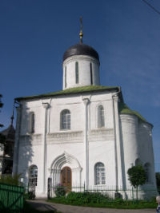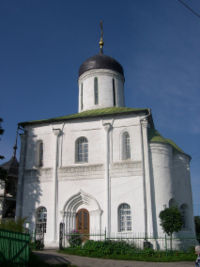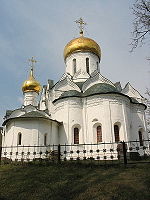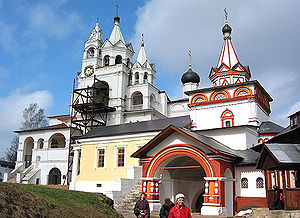
Zvenigorod
Encyclopedia

Moscow Oblast
Moscow Oblast , or Podmoskovye , is a federal subject of Russia . Its area, at , is relatively small compared to other federal subjects, but it is one of the most densely populated regions in the country and, with the 2010 population of 7,092,941, is the second most populous federal subject...
, Russia
Russia
Russia or , officially known as both Russia and the Russian Federation , is a country in northern Eurasia. It is a federal semi-presidential republic, comprising 83 federal subjects...
. Population:
History
The community has existed since the 12th century, although its first written mention is dated 1338. The town's name is based either on a personal name (cf. Zvenislav, Zvenimir) or on a hydronym (cf. the rivers Zvinech, Zvinyaka, Zveniga); the derivation from "town of ringing (bells)" is a folk etymology.Zvenigorod rose to prominence in the late 14th century after it was bequeathed by Dmitry Donskoy to his second son Yuri, who founded his residence on the steep bank of the Moskva River
Moskva River
The Moskva River is a river that flows through the Moscow and Smolensk Oblasts in Russia, and is a tributary of the Oka River.-Etymology:...
. The local kremlin
Kremlin
A kremlin , same root as in kremen is a major fortified central complex found in historic Russian cities. This word is often used to refer to the best-known one, the Moscow Kremlin, or metonymically to the government that is based there...
, called Gorodok, contains the only fully preserved example of 14th-century Muscovite architecture, the Assumption Cathedral (1399). The cathedral's interior features frescoes by the great Andrei Rublev
Andrei Rublev
Andrei Rublev is considered to be the greatest medieval Russian painter of Orthodox icons and frescoes.-Biography:...
.

Vasili II of Russia
Vasily II Vasiliyevich Tyomniy was the Grand Prince of Moscow whose long reign was plagued by the greatest civil war of Old Russian history....
(1425–1462). After their party was defeated, the town was incorporated into Muscovy.
Zvenigorod was granted municipal rights in 1784. By the late 19th century, the town gained popularity among the intelligentsia
Intelligentsia
The intelligentsia is a social class of people engaged in complex, mental and creative labor directed to the development and dissemination of culture, encompassing intellectuals and social groups close to them...
as a fashionable banlieue
Banlieue
In francophone areas, banlieues are the "outskirts" of a city: the zone around a city that is under the city's rule.Banlieues are translated as "suburbs", as these are also residential areas on the outer edge of a city, but the connotations of the term "banlieue" in France can be different from...
of Moscow. Many extravagant dacha
Dacha
Dacha is a Russian word for seasonal or year-round second homes often located in the exurbs of Soviet and post-Soviet cities. Cottages or shacks serving as family's main or only home are not considered dachas, although many purpose-built dachas are recently being converted for year-round residence...
s were built in the neighbourhood. Some of these house museums of Sergey Taneev, Anton Chekhov
Anton Chekhov
Anton Pavlovich Chekhov was a Russian physician, dramatist and author who is considered to be among the greatest writers of short stories in history. His career as a dramatist produced four classics and his best short stories are held in high esteem by writers and critics...
, and Isaac Levitan
Isaac Levitan
Isaac Ilyich Levitan was a classical Russian landscape painter who advanced the genre of the "mood landscape".-Youth:...
.
Savvino-Storozhevsky MonasterySavvino-Storozhevsky MonasteryThe Savvino-Storozhevsky Monastery is a Russian Orthodox monastery in Zvenigorod.In 1398, Prince Yuri asked St. Savva Storozhevsky, one of the first disciples of Sergii Radonezhsky, to go to Zvenigorod and to establish a monastery on the Storozhi Holm...

Fresco
Fresco is any of several related mural painting types, executed on plaster on walls or ceilings. The word fresco comes from the Greek word affresca which derives from the Latin word for "fresh". Frescoes first developed in the ancient world and continued to be popular through the Renaissance...
es in the altar
Altar
An altar is any structure upon which offerings such as sacrifices are made for religious purposes. Altars are usually found at shrines, and they can be located in temples, churches and other places of worship...
date back to the 1420s, but the rest of interior was painted in 1656. A magnificent iconostasis
Iconostasis
In Eastern Christianity an iconostasis is a wall of icons and religious paintings, separating the nave from the sanctuary in a church. Iconostasis also refers to a portable icon stand that can be placed anywhere within a church...
in five tiers and the Stroganov-school
Stroganov School
Stroganov School is a conventional name for the last major Russian icon-painting school, which thrived under the patronage of the fabulously rich Stroganov family of merchants in the late 16th and 17th century....
heaven gates were installed in 1652.
In 1650, the monastery was chosen by Tsar Alexis
Alexis I of Russia
Aleksey Mikhailovich Romanov was the Tsar of Russia during some of the most eventful decades of the mid-17th century...
as his suburban residence. In five years, they constructed a white-stone royal palace and a festive chamber for tsaritsa
Tsaritsa
Tsaritsa , formerly spelled czaritsa , is the title of a female autocratic ruler of Bulgaria or Russia, or the title of a tsar's wife....
. The cloister
Cloister
A cloister is a rectangular open space surrounded by covered walks or open galleries, with open arcades on the inner side, running along the walls of buildings and forming a quadrangle or garth...
was encircled with stone walls and towers, patterned after those of the Troitse-Sergiyeva Lavra
Troitse-Sergiyeva Lavra
The Trinity Lavra of St. Sergius is the most important Russian monastery and the spiritual centre of the Russian Orthodox Church. The monastery is situated in the town of Sergiyev Posad, about 70 km to the north-east from Moscow by the road leading to Yaroslavl, and currently is home to...
. Particularly noteworthy is a large belfry, erected in four bays in 1650 and crowned with three tents and a clocktower. A church over the holy gates was consecrated to the Holy Trinity
Trinity
The Christian doctrine of the Trinity defines God as three divine persons : the Father, the Son , and the Holy Spirit. The three persons are distinct yet coexist in unity, and are co-equal, co-eternal and consubstantial . Put another way, the three persons of the Trinity are of one being...
in 1652.
After the death of Feodor III
Feodor III of Russia
Feodor III Alexeevich of Russia was the Tsar of all Russia between 1676 and 1682....
, who spent most of his time there, the monastery declined. In May 1918, when the Bolshevik
Bolshevik
The Bolsheviks, originally also Bolshevists , derived from bol'shinstvo, "majority") were a faction of the Marxist Russian Social Democratic Labour Party which split apart from the Menshevik faction at the Second Party Congress in 1903....
s tried to seize the relics of St. Savva, several persons were shot dead. In 1985, the cloister was assigned to the Danilov Monastery
Danilov Monastery
Danilov Monastery, in full Svyato-Danilov Monastery or Holy Danilov Monastery , is a monastery on the right bank of the Moskva River in Moscow, Russia...
in Moscow. St. Savva's relics were returned to the monastery in 1998.


